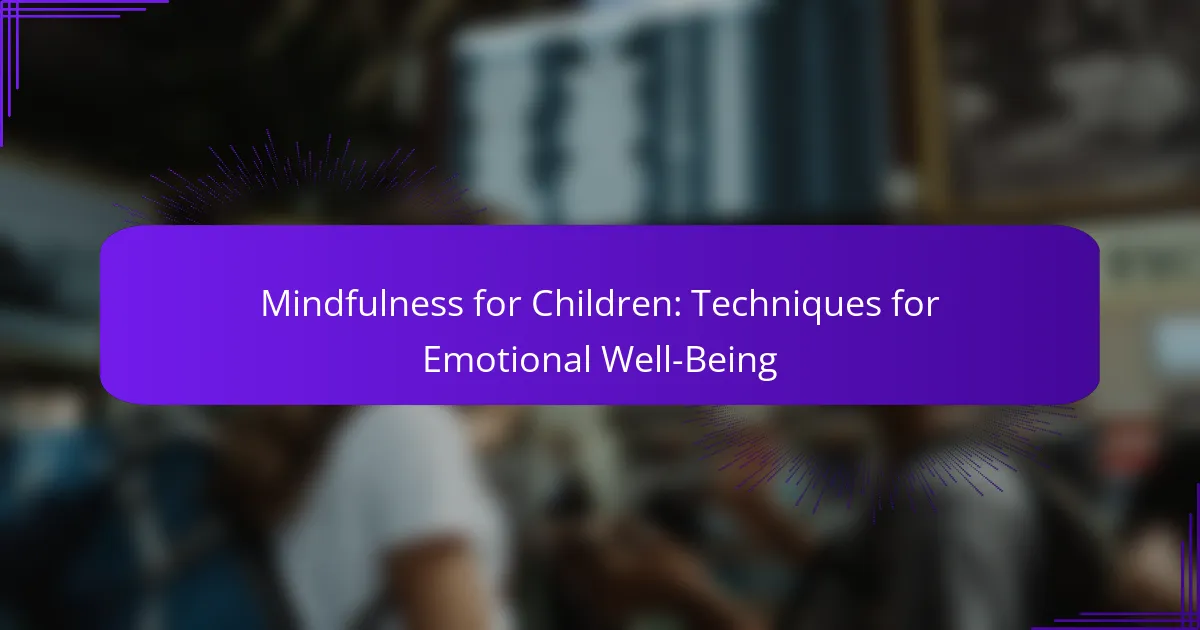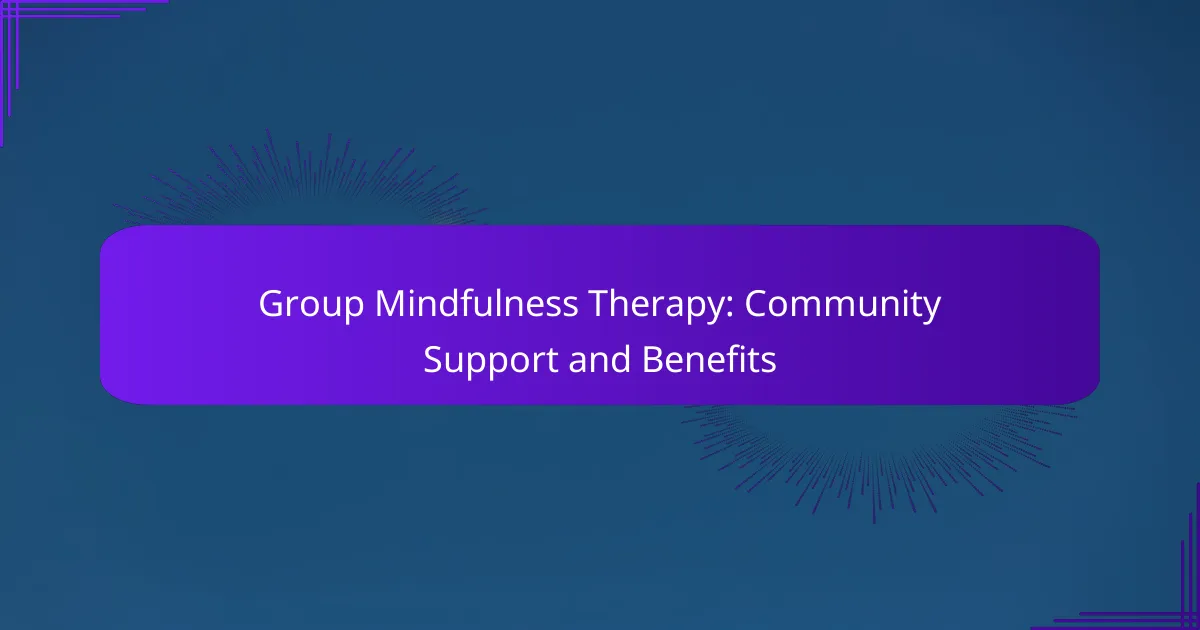Mindfulness techniques can play a crucial role in enhancing emotional well-being in children by equipping them with tools to manage their feelings and reactions. By fostering self-awareness and promoting calmness, these practices help children develop resilience and reduce anxiety. Parents can easily incorporate mindfulness into daily routines, creating a supportive environment for emotional growth and focus.
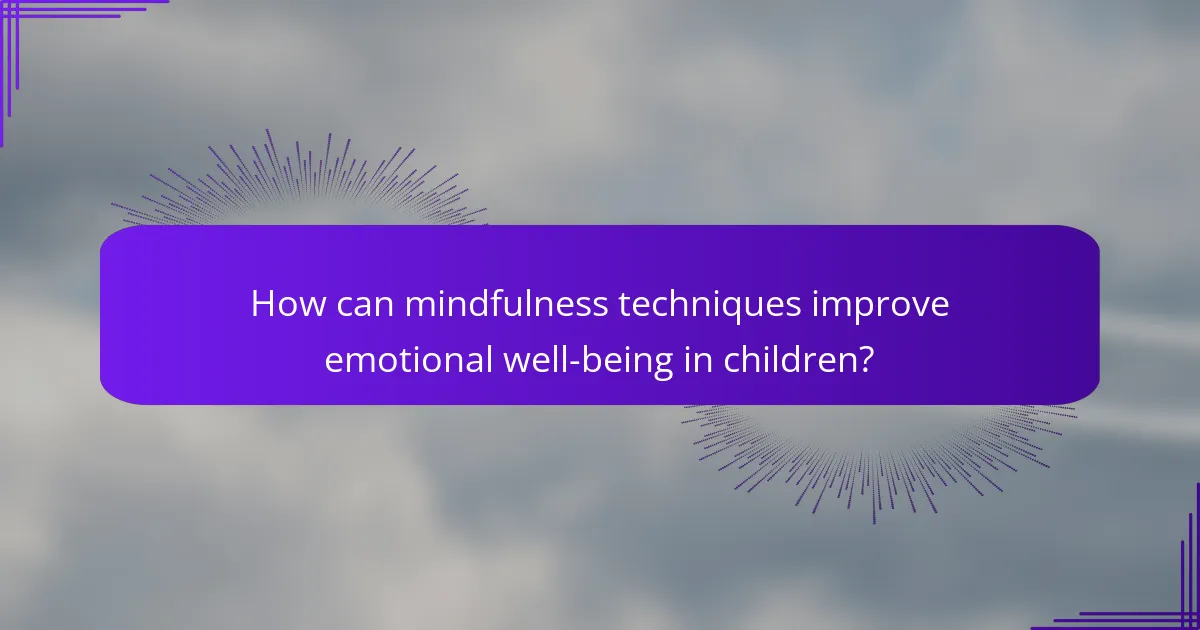
How can mindfulness techniques improve emotional well-being in children?
Mindfulness techniques can significantly enhance emotional well-being in children by helping them manage their feelings and reactions. These practices promote self-awareness, reduce negative emotions, and foster a sense of calm and balance.
Reduces anxiety and stress
Mindfulness techniques such as deep breathing and guided imagery can effectively reduce anxiety and stress in children. By focusing on the present moment, children learn to detach from overwhelming thoughts and feelings, leading to a calmer state of mind.
Simple practices like the “5-4-3-2-1” grounding technique, where children identify five things they can see, four they can touch, three they can hear, two they can smell, and one they can taste, can help them feel more centered and less anxious.
Enhances focus and attention
Practicing mindfulness can improve children’s focus and attention span. Techniques such as mindful breathing or short meditation sessions encourage children to concentrate on their breath or a specific thought, which can enhance their ability to stay engaged in tasks.
Incorporating mindfulness into daily routines, like a few minutes of meditation before homework, can help children develop better concentration skills and reduce distractions.
Promotes emotional regulation
Mindfulness helps children recognize and manage their emotions more effectively. By becoming aware of their feelings without judgment, they can learn to respond to situations rather than react impulsively.
Encouraging children to pause and take a few deep breaths when they feel upset can be a practical way to help them regulate their emotions and make more thoughtful choices in challenging situations.
Encourages empathy and compassion
Mindfulness practices can foster empathy and compassion in children by promoting an understanding of their own emotions and those of others. Activities like sharing feelings during group discussions or practicing loving-kindness meditation can enhance their ability to connect with peers.
Engaging in community service or group mindfulness exercises can also help children develop a sense of compassion, making them more aware of the feelings and needs of others around them.
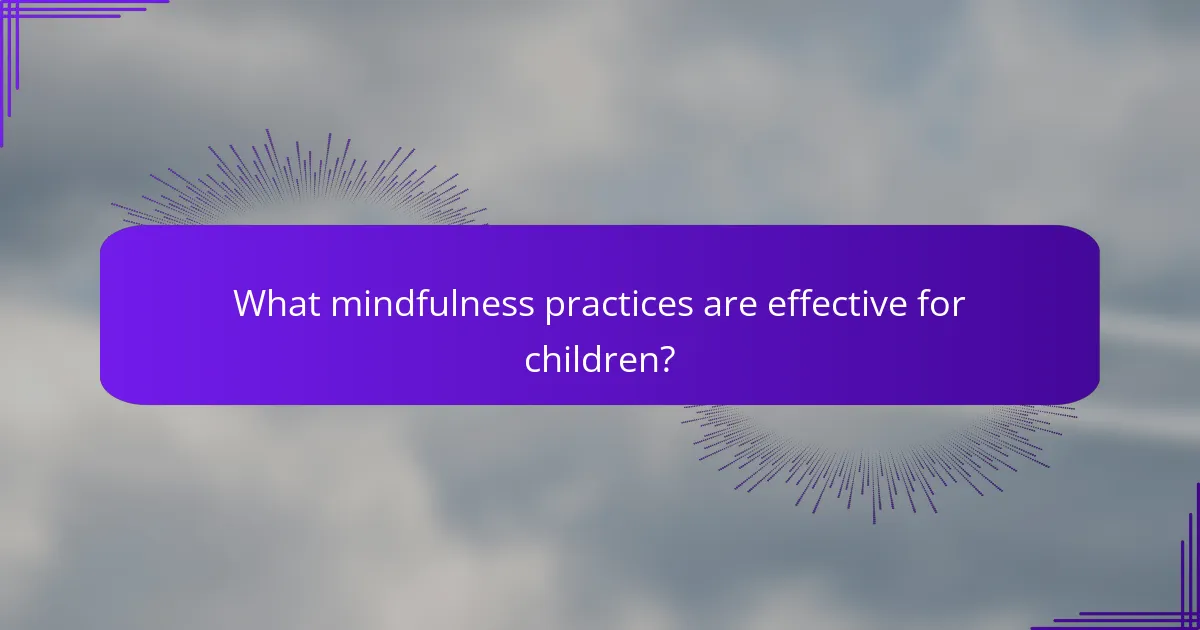
What mindfulness practices are effective for children?
Effective mindfulness practices for children include techniques that promote emotional well-being and self-regulation. These practices help children develop awareness of their thoughts and feelings, fostering resilience and reducing anxiety.
Breathing exercises
Breathing exercises are simple yet powerful tools for helping children manage stress and anxiety. Techniques such as deep belly breathing or the “5-5-5” method—inhale for five seconds, hold for five seconds, and exhale for five seconds—can be easily taught and practiced. Encourage children to focus on their breath, which can ground them in the present moment.
To make it engaging, consider using visuals or props, like a stuffed animal that rises and falls with their breath. Regular practice can lead to improved emotional regulation and a sense of calm.
Guided imagery
Guided imagery involves leading children through a mental visualization of a peaceful scene or scenario, promoting relaxation and focus. This technique can be particularly effective before bedtime or during moments of stress. You might describe a serene beach or a tranquil forest, encouraging them to imagine the sights, sounds, and smells.
To enhance the experience, use calming music or sound effects. Practicing guided imagery regularly can help children develop a toolkit for managing overwhelming emotions and fostering creativity.
Mindful movement
Mindful movement combines physical activity with awareness, helping children connect their bodies and minds. Activities like yoga, tai chi, or even simple stretching can be beneficial. Encourage children to pay attention to their movements and how their bodies feel during each exercise.
Incorporating mindful movement into daily routines can enhance focus and reduce restlessness. Aim for short sessions of 10-15 minutes, making it fun by using playful themes or music.
Gratitude journaling
Gratitude journaling encourages children to reflect on positive experiences and express appreciation. This practice can be as simple as writing down three things they are thankful for each day. It helps shift their focus from negative thoughts to positive ones, promoting emotional resilience.
To make it engaging, provide colorful notebooks or stickers for personalization. Encourage children to revisit their entries regularly, reinforcing a positive mindset and emotional well-being.
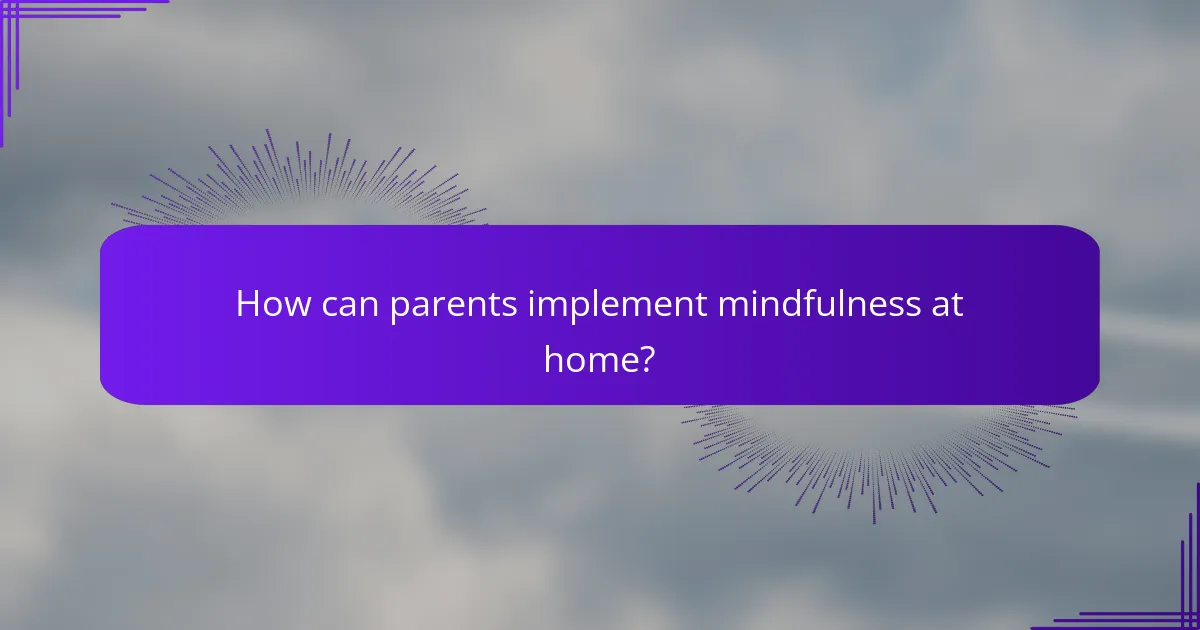
How can parents implement mindfulness at home?
Parents can implement mindfulness at home by integrating simple practices into daily routines. This can help children develop emotional awareness and resilience, fostering a sense of calm and focus.
Establishing a routine
Creating a consistent mindfulness routine is essential for children to engage with the practice effectively. Set aside specific times each day for mindfulness activities, such as morning breathing exercises or evening reflections. Consistency helps children understand the importance of mindfulness in their lives.
Consider incorporating mindfulness into existing routines, such as during meals or before bedtime. This can make it easier for children to adopt these practices without feeling overwhelmed.
Creating a calm environment
A calm environment is crucial for effective mindfulness practice. Designate a quiet space in your home where children can practice mindfulness without distractions. This area could include comfortable seating, soft lighting, and calming decorations.
Encourage children to personalize their mindfulness space with items that bring them peace, such as plants, calming colors, or soothing sounds. A tranquil environment can enhance their ability to focus and relax during mindfulness exercises.
Using mindfulness apps
Mindfulness apps can be valuable tools for children to learn and practice mindfulness techniques. Many apps offer guided meditations, breathing exercises, and mindfulness games tailored for kids. Look for age-appropriate options that engage children while teaching them essential skills.
Some popular mindfulness apps include Headspace for Kids, Smiling Mind, and Calm. These platforms often provide free content, making them accessible for families looking to incorporate mindfulness without significant costs.
Participating in family mindfulness activities
Engaging in mindfulness activities as a family can strengthen bonds and promote emotional well-being. Consider activities like mindful walking, where everyone focuses on their surroundings and sensations while walking together. This encourages connection with nature and each other.
Another option is to practice gratitude together by sharing things each family member is thankful for during dinner. This simple practice fosters a positive mindset and encourages emotional expression among family members.
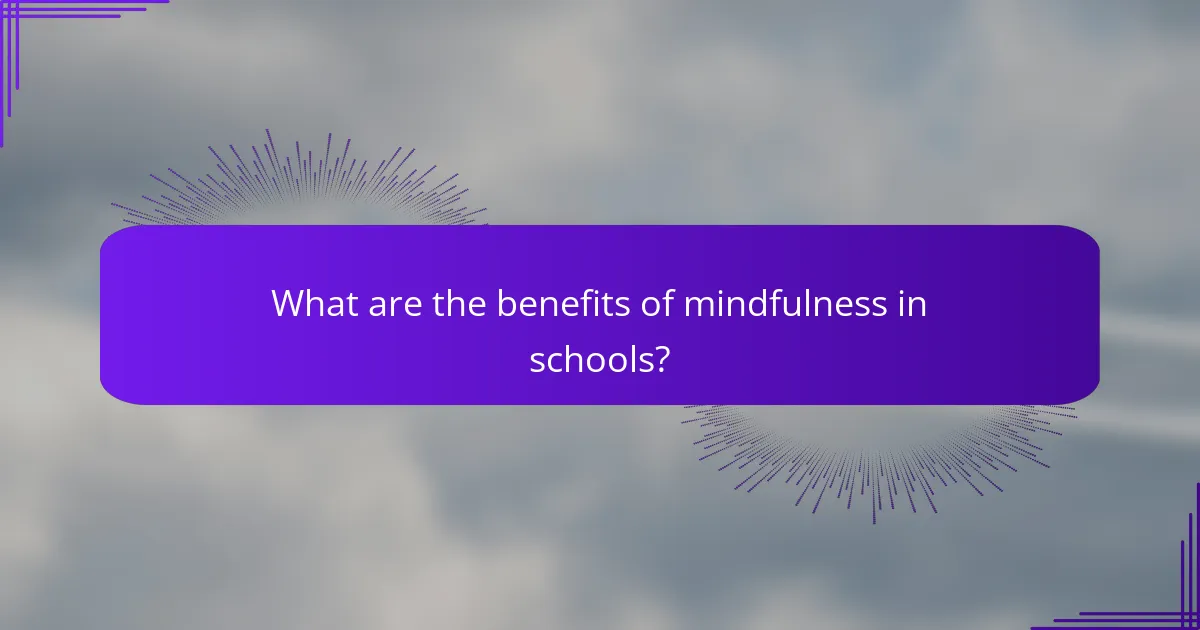
What are the benefits of mindfulness in schools?
Mindfulness in schools offers numerous benefits, including enhanced emotional regulation, improved focus, and a more positive school environment. These advantages contribute to the overall well-being of students, fostering a supportive atmosphere for learning and personal growth.
Improved student behavior
Implementing mindfulness practices can lead to significant improvements in student behavior. Students who engage in mindfulness are often better at managing their emotions, which reduces instances of disruptive behavior in the classroom.
Techniques such as breathing exercises or guided imagery can help students pause and reflect before reacting impulsively. This proactive approach encourages self-control and promotes a calmer classroom environment.
Higher academic performance
Mindfulness has been linked to higher academic performance among students. By enhancing focus and concentration, mindfulness practices allow students to engage more deeply with their studies.
Regular mindfulness sessions can improve attention spans, enabling students to absorb information more effectively. Schools that incorporate mindfulness into their curriculum often see a rise in test scores and overall academic achievement.
Better peer relationships
Mindfulness fosters better peer relationships by promoting empathy and understanding among students. When children practice mindfulness, they become more aware of their own feelings and those of others, which enhances social interactions.
Activities like group mindfulness exercises can strengthen bonds between classmates, encouraging cooperation and reducing conflicts. This supportive atmosphere helps students develop essential social skills that benefit them both in and out of school.

What resources are available for teaching mindfulness to children?
There are various resources designed to help teach mindfulness to children, including books, online courses, and workshops. These tools can provide parents and educators with effective techniques to foster emotional well-being in young learners.
Books for children
Books specifically aimed at children can introduce mindfulness concepts in an engaging way. Titles like “A Handful of Quiet” by Thich Nhat Hanh and “Mindful Monkey, Happy Panda” by Lauren Alderfer offer stories and exercises that make mindfulness relatable and fun.
When selecting books, look for those that include illustrations and activities to keep children interested. Aim for age-appropriate content, generally targeting ages 4 to 12, to ensure the material resonates with their developmental stage.
Online courses for parents
Online courses can equip parents with the skills to teach mindfulness effectively. Platforms like Udemy and Coursera offer courses that cover mindfulness techniques, practical exercises, and ways to integrate mindfulness into daily routines.
Consider courses that provide interactive elements, such as guided meditations or community forums, to enhance learning. Look for programs that range from a few hours to several weeks, allowing flexibility based on your schedule.
Workshops for educators
Workshops for educators focus on integrating mindfulness practices into classroom settings. These sessions often cover strategies for teaching mindfulness, creating a calm classroom environment, and addressing students’ emotional needs.
Seek workshops that offer hands-on activities and resources for immediate implementation. Many organizations provide certification programs, which can enhance your credentials and provide a structured approach to teaching mindfulness in schools.
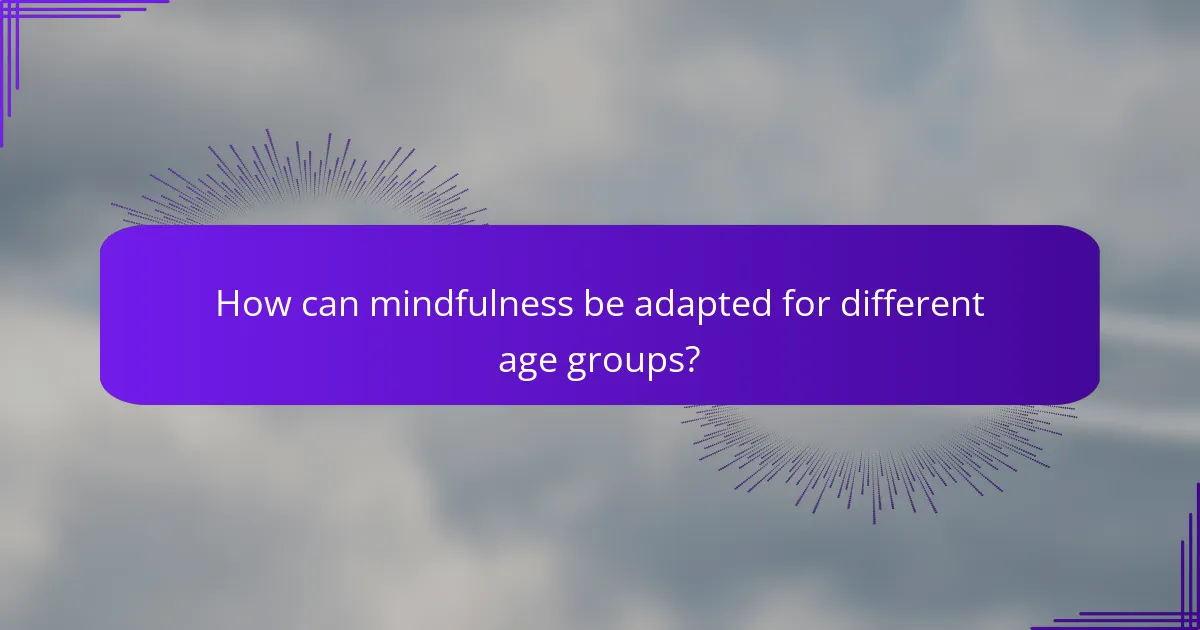
How can mindfulness be adapted for different age groups?
Mindfulness can be tailored to suit various age groups by adjusting techniques and activities to match their developmental stages. Younger children may benefit from playful, simple practices, while older children can engage in more structured mindfulness exercises.
Mindfulness Techniques for Toddlers
For toddlers, mindfulness can be introduced through simple activities that focus on sensory experiences. Techniques like “mindful breathing” can be as straightforward as taking deep breaths while counting to three, encouraging them to notice how their bodies feel.
Incorporating movement, such as gentle stretching or dancing, can also help toddlers connect with their bodies. Short, interactive games like “freeze dance” can promote awareness of their physical sensations and emotions.
Mindfulness Practices for Preschoolers
Preschoolers can engage in mindfulness through storytelling and imaginative play. Guided imagery, where children visualize a peaceful scene, can help them develop focus and calmness. Simple breathing exercises, such as pretending to blow up a balloon, can make the practice fun and relatable.
Activities like “mindful walking,” where children pay attention to their steps and surroundings, can enhance their awareness. Parents and educators should keep sessions brief, around 5-10 minutes, to maintain engagement.
Mindfulness Strategies for School-Aged Children
School-aged children can benefit from more structured mindfulness practices, such as meditation or yoga. Techniques like “body scan” meditation help them develop a deeper awareness of their emotions and physical sensations. Sessions can last from 10 to 20 minutes, depending on their attention spans.
Incorporating mindfulness into daily routines, such as during transitions or before tests, can help children manage stress. Encouraging journaling or drawing as a form of expression can also support emotional well-being.
Mindfulness Approaches for Adolescents
Adolescents can explore mindfulness through more advanced practices, such as mindfulness-based stress reduction (MBSR). Techniques like mindful breathing, meditation, and reflective journaling can help them navigate the complexities of their emotions and social interactions.
Encouraging group discussions about mindfulness experiences can foster a sense of community and support. Sessions can range from 20 to 30 minutes, allowing for deeper exploration of feelings and thoughts.
